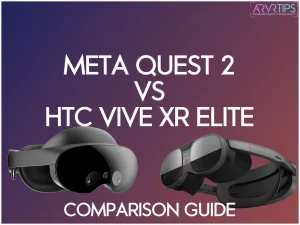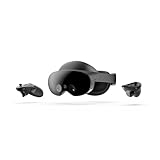In this guide, I’ll show you everything you need to know if you are comparing the Meta Quest Pro vs HTC Vive XR Elite to decide which premium VR headset is worth buying.
To help you decide, I’ve compiled all of the important facts and information about each headset below. I’ve gotten the chance to wear and use each headset side-by-side for several days. If you are looking to pick one of these headsets up, I can help you decide!
If you want me to compare any other specs on the Quest Pro or XR Elite, comment down at the bottom of this guide. Keep reading for full details!
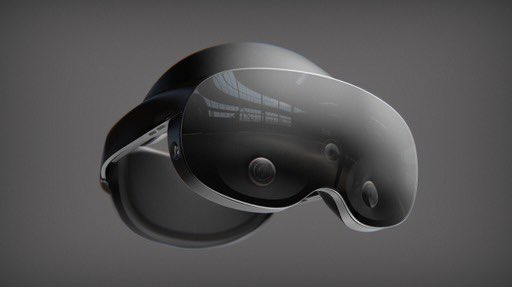
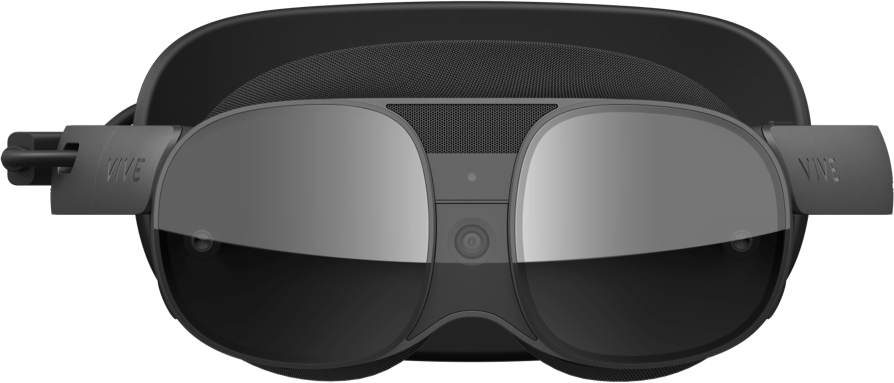
At a Glance
The Meta Quest Pro is a professional headset that packs all of virtual reality’s current technology into one spot. Face, eye, and hand tracking are superior and the controllers feel more premium. Meta’s software platform is busier, with better compatibility and developer support.
However, the Quest Pro has average color passthrough, which mutes the capabilities of mixed reality. Battery life is also a concern – I only get 75 minutes or so during average use.
HTC has swung hard with the XR Elite and time will tell if consumers will buy into the product or not. The price is more aggressive, $300 less or more depending on where you live. The mixed reality mode is much clearer, which is an area HTC should focus on.
How to Buy
Use the links below to buy the HTC Vive XR Elite from Amazon and Meta Quest Pro around the world:
Meta Quest Pro vs HTC Vive XR Elite: Detailed Comparison
Display Lenses
The Meta Quest Pro features pancake lenses, which are more compact compared to the traditional fresnel lenses found on the Quest 2 headset. Pancake lenses use polarization to fold the optical light path like a mirror using less space.
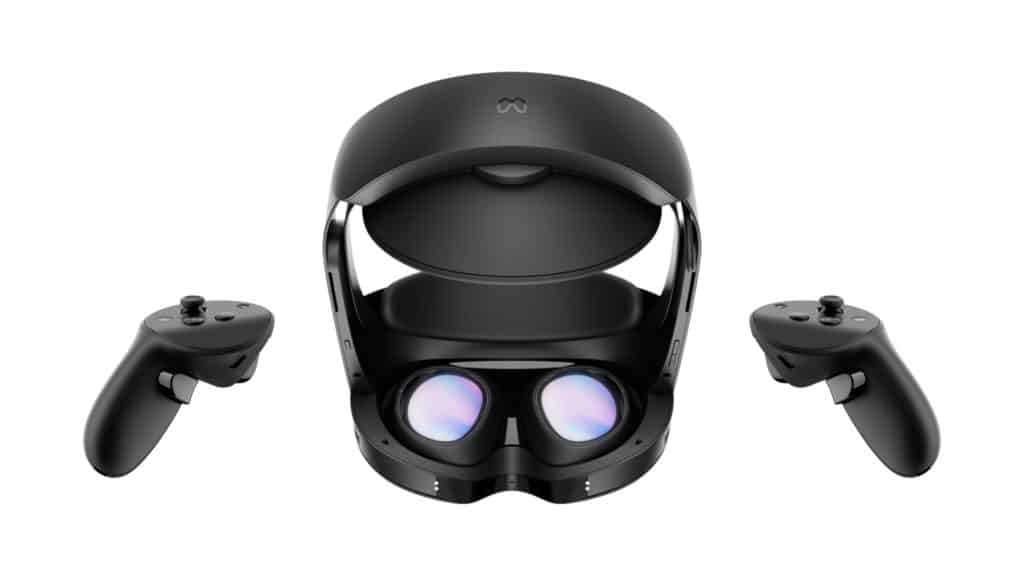
Like the Meta Quest Pro, the HTC Vive XR Elite has two pancake lenses instead of a traditional LCD screen. Pancake lenses have a smaller form factor, which allows both headsets to take up less space and weight overall.

Winner: Draw
Resolution
The resolution of each eye on the Quest Pro is 1920×1800 and 3820×3600 combined. The field of view on the headset is 106 degrees horizontal. This is about 10% larger than the Quest 2, which has an FoV of 95 degrees.
The resolution for each pancake lenses on the XR Elite is 1920×1920 per eye and 3840×1980 combined, providing clear and vibrant visuals for all apps. You will also get a wide 110-degree Field of View that will provide the best picture for your headset.
Overall, HTC has done a slightly better job on the display resolution of the XR Elite. The slightly extra resolution is not very noticeable, but the field of view does feel larger.
Winner: HTC Vive XR Elite
Depth Sensor
The HTC Vive XR Elite has a depth sensor and four tracking cameras outside the headset to enhance tracking accuracy and immersion. This depth sensor also works in many lighting conditions and will ensure sufficient play area.
Depth is also used to calculate accurate distances in space during mixed reality play.
The Quest Pro does not contain any depth sensor. This was a rumored feature that was removed during the final testing stages of the headset.
Winner: HTC Vive XR Elite
IPD Adjustment
The Quest Pro features an automatic IPD adjustment between 55 and 75 mm wide. This is much more than the Quest 2’s 58 to 68 mm range. The software adjusts your IPD in the display automatically to match the wearer by using the inward facing cameras.
The HTC Vive XR Elite has an adjustable IPD slider on the outside of the headset. This means that you can turn the dial clockwise if you want to increase the distance between the lenses, and turn it counter-clockwise to decrease the distance between the lenses. The range of the IPD is 54 to 73mm.
Overall, the software adjustment on the Quest Pro works nicely. It’s a great use of the inward facing cameras which watch your face while you play in virtual reality.
Winner: Meta Quest Pro
Diopter Dials
The Meta Quest Pro doesn’t feature any diopter adjustment.
The XR Elite headset features diopter dials that you can adjust for each lens to ensure you are getting the crispest, sharp image possible for each eye. This allows users who usually wear glasses to take them off while wearing the headset and get the most comfort.
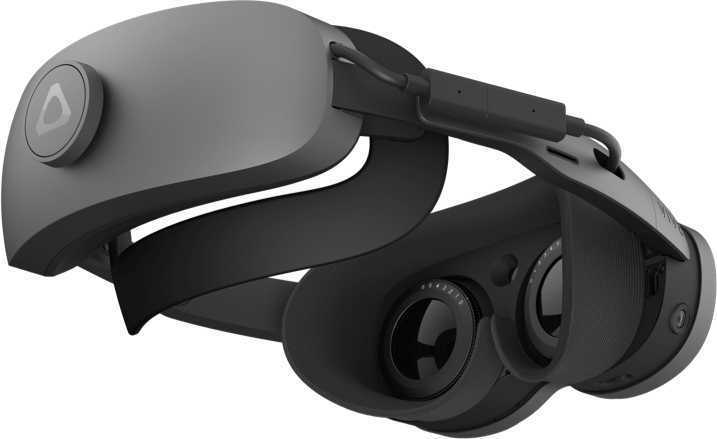
Winner: HTC Vive XR Elite
Refresh Rate
The maximum refresh rate on both the Quest Pro and the XR Elite is 90hz. For the most part, this will ensure a smooth and seamless experience when playing with the headset. This refresh rate comes in handy when playing games that have more speed and motion.
Winner: Draw
CPU
The Quest Pro features the Qualcomm Snapdragon XR2+ system on a chip. It is the first processor developed since Meta and Qualcomm announced their partnership together. The XR2+ offers 50% more power than the original XR2 found in the Quest 2.
The Vive XR Elite runs on the Qualcomm Snapdragon XR2 processor, the same processor on which the Meta Quest 2 and Pico 2 headsets operate.
Both headsets comes with 12 GB of memory.
Winner: Meta Quest Pro
Storage Options
The Meta Quest Pro comes standard with 256 GB of storage space. Some VR games have gotten quite big lately – 25 GB or more for a single game.
The XR Elite is only available with a standard 128 GB option. HTC has yet to announce whether more models with higher storage are in the works.
Overall, the extra space is a key feature on the Quest Pro. Expect that virtual reality experiences will get larger over time and the extra storage is a welcome addition.
Winner: Meta Quest Pro
Strap
The Quest Pro features a unique halo strap which fits around your head. Unlike the Quest 2, the strap is fixed to the frame of the headset and cannot be swapped out, like the Quest 2 can be with an elite strap. The strap does not have a top loop like the Quest 2 does.
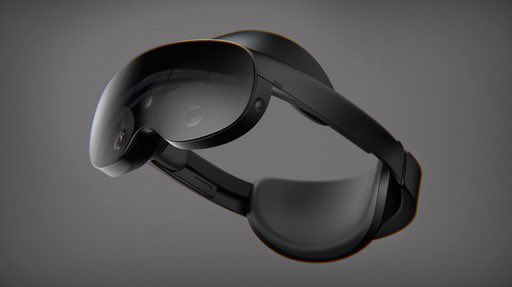
The HTC Vive XR Elite has a battery cradle sits on the back of your head, connected with straps that go to the front where the lenses are. This makes the headset more comfortable and fits many different head sizes. You also don’t have to worry about messing your hair up while playing VR anymore.
HTC’s biggest advantage is that the battery can be removed and the headset can be worn like a regular pair of glasses. This is a great feature that makes the hardware better to use for longer periods.
However, comparing purely the headstraps, I would call this a draw. Both headsets fit generally well for how heavy they are.
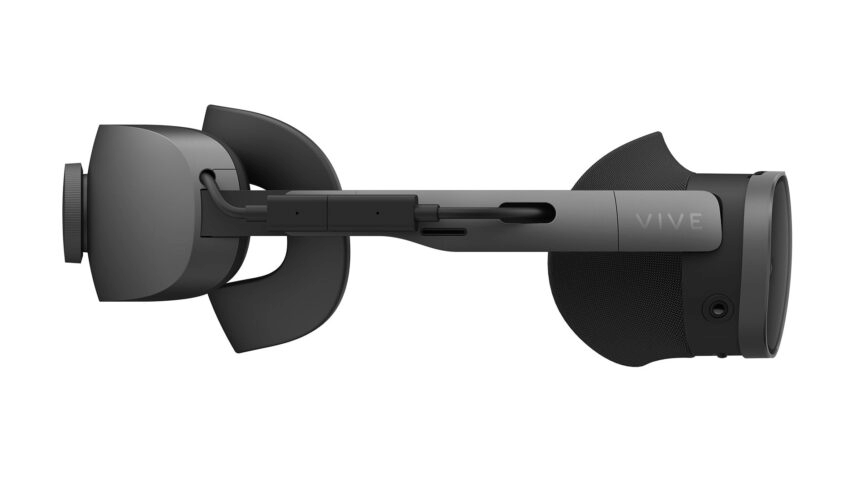
Winner: It Depends
Tracking
Both the Quest Pro and the Vive XR elite features inside-out tracking with four wide FOV cameras that face outward from the headset. You do not need to buy or setup any base stations to get tracking working. The spatial accuracy is high.

Winner: Draw
Battery
Both the Meta Quest Pro and HTC Vive XR Elite offer up to two hours of battery life. This is highly dependent on what you are doing on the headset. High intensity graphics are serious mixed reality apps drain the battery faster and you will get 60 minutes or so.
The big advantage for battery goes to HTC for designing a modular battery pack that can be removed. When it is off, the XR Elite feels like you are wearing glasses. The battery will only last a few minutes in the glasses mode, so you have to plug into a compatible USB-C charger or Android phone to provide charging.
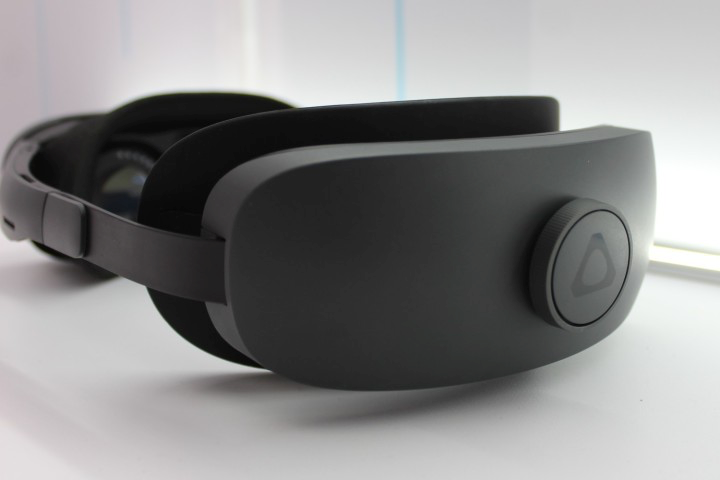
Winner: HTC Vive XR Elite
Speakers
Both headsets have immersive audio throughout the headset. The speakers blend right into the headset on both sides just above your ears, so you can’t tell they are there.
The audio is pretty good for virtual reality, though don’t expect surround sound without some more immersive headphones. Both devices also feature a built-in microphone.
Winner: Draw
Weight
The weight of the Meta Quest Pro is 720 grams. This is 50% heavier than the Quest 2. However, Meta has done a better job distributing weight throughout the headset. Where an elite strap was recommended on the Quest 2, I think the Pro is fine to wear on its own.
The Vive XR Elite is exceptionally lightweight and comfortable on the head. With the battery cradle attached, the entire headset weighs 625g. You can also remove the battery cradle and wear the headset in glasses-only mode. This drops the headset’s weight to 273g.

Winner: HTC Vive XR Elite
Controllers
The Quest Pro features all new Pro Touch controllers. Each controller has 3 cameras on it and a Qualcomm Snapdragon 662 processor in it. This allows your controller to track its position and movement in space all on its own, without the use of the headset at all. The processor in the controller allows for full 360-degree range of motion.

Included with the headset comes two Vive XR controllers, dubbed 6DoF (6 degrees of freedom). Each controller weighs about 142g and contains capacitive face buttons, joysticks, a touchpad, and both index and middle finger triggers. The controllers are slick and very comfortable to hold for long periods.

Overall, the design of the headsets is better for Meta. However, the Pro Touch controllers only get about 5 hours of battery life, while the Vive XR controllers get 15 hours. Meta does make it easy by including a charging dock for the headset and controllers though.
Winner: Meta Quest Pro
Hand Tracking
Both headsets have built-in hand tracking, which means you don’t need to use the controllers for certain compatible games. Using only your hands and fingers, you can play compatible games with gesture controls.
In theory, both headsets work well. However, Meta has been fine-tuning their hand tracking for the past few years and their solution works better. Hand tracking is performed at 60 frames per second on the Quest Pro, which helps get high accuracy.
Winner: Meta Quest Pro
Passthrough Cameras
Both VR headsets feature full color passthrough, which allows you to see the real world outside your headset. This is achieved with a 16 megapixel (MP) camera placed in the center of each headset.
While technically the same resolution, I really like how HTC’s solution works. The image is much clearer and you can do things like read text easier with the XR Elite.

Winner: HTC Vive XR Elite
Games
The Meta game store is the largest standalone VR headset digital store in the world. You can download and play thousands of official games, plus early demos from the App Lab. Meta has also been aggressive in purchasing VR development companies and making games like Beat Saber and Population: ONE exclusive to their platform.

The XR Elite supports standalone Android-based games and PC VR games (wired or wireless) through the Viveport platform. Along with the headset, HTC announced a number of new games coming over from the Quest platform, including:
- Green Hell VR (adventure game)
- Les Mills Bodycombat (health & fitness)
- Unplugged: Air Guitar (music)
- Figmin XR (creativity & education)
- Glimpse (entertainment)

More and more games are set to be released, along with games that HTC said will work with both VR and MR (mixed reality). This is HTC’s first real standalone headset marketed for gaming, so it might take a while for developers to add support for Viveport’s Android platform.
Winner: Meta Quest
Price
The Meta Quest Pro retails for $1499. For this price, you get:
- Meta Quest Pro VR headset
- (2x) Touch Pro Controllers – The controllers come with rechargeable batteries, built-in sensors for tracking, improved ergonomics, and an upgraded haptic system.
- (2x) Stylus Tips – This Quest Pro accessory is mounted to the bottom of the Touch Pro controllers and allows you to comfortably write and draw in VR.
- (2x) Partial Light Blockers – The headset is designed so that while in VR, you will still be aware of the physical environment around you. In other words, you won’t be fully immersed in VR if you use the Meta Quest Pro without the partial light blockers. They are designed to block out the outside world.
- Charging Dock – You can use the charging dock to simultaneously charge the Quest Pro and the two Touch Pro controllers at the same time.
- (2x) Wrist Straps – You can attach this accessory to the bottom of the controllers for extra security.
- Protective Cover – The protective cover will help further protect your headset, whether in transit or at home.
- (2x) Charging Cables & Adapter – You can use the charging cables and adapter to charge your headset and Touch Pro controllers whenever you are far away from the charging dock.
The HTC Vive XR Elite costs $1099, which is $400 cheaper. For this price, you get the headset, two controllers, and a charging cable and that’s it.
When you take into account the extra accessories and features that are included for the Quest Pro, the cost of these two headsets is very similar. The Elite is cheaper technically, but you should be aware of what you get when you buy either device.
Winner: HTC Vive XR Elite
HTC Vive XR Elite vs Meta Quest Pro: The Winner
Best Overall
The best overall VR headset out of these two is the Meta Quest Pro.
Both VR headsets provide a lot of premium and functional features. HTC has done an interesting job trying to be competitive with its VR technology, which is something I felt they missed with the Vive Focus, Flow and other recent headsets.
The Elite has a better display, diopter adjustment, color passthrough, removable battery, and better price point. However, Meta has a better platform for games and apps and both their controller and their hand tracking technology is superior. Plus, the Quest Pro has eye tracking and some other cool productivity features.
Best For Gaming
For gaming, the best headset out of these two is the Meta Quest Pro. Meta has done a strong job building out its Android platform over the past 5 years. Not only does their official store have over 1000 titles on it, but the experimental App Lab is full of thousands more. If you like to play games and try new things, then the Quest Pro is the better option.
Best For Productivity
Again, the best headset for productivity is the Meta Quest Pro. It has a number of business-focused apps that allow you to collaborate and work in virtual reality. You can map your computer keyboard and mouse into your metaverse and open up virtual computer displays that mirror real life.
The controllers on the Quest Pro have stylus tips, which make drawing and writing in VR more fine-tuned.
More Comfortable
The HTC Vive XR Elite is the more comfortable headset to wear. The rear battery cradle is a really great design. Removing it allows you to watch media and play games on what feels like a regular pair of glasses, which is an awesome feature.
Conclusion
Overall, HTC’s biggest drawback is how its chosen to build out its platform over the past five years. Viveport started out at a cute Steam alternative, but it didn’t join the Android world for standalone VR until too late. Meanwhile, Meta has been buying up VR companies and expanding its store with games and productivity apps.
Because of that, I feel like HTC has a solid headset in the XR Elite that suffers from a lack of content. If you are primarily a PC VR gamers, then the Elite is an excellent choice. If you don’t have a gaming PC, then I feel like the Meta Quest Pro has more to offer you, despite its higher price point.
Use the links below to get your headset today!

